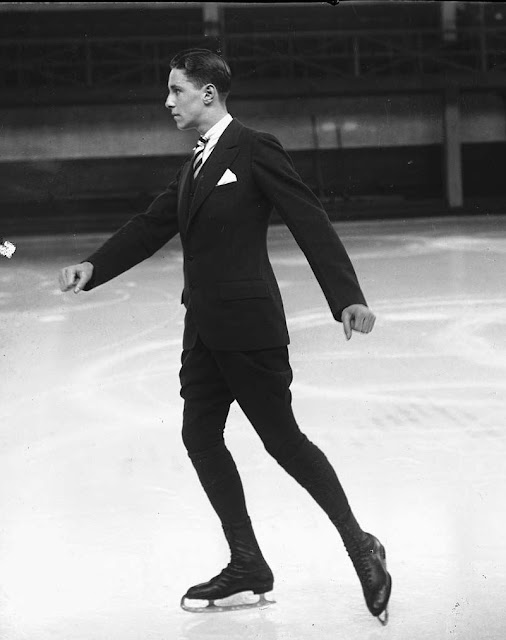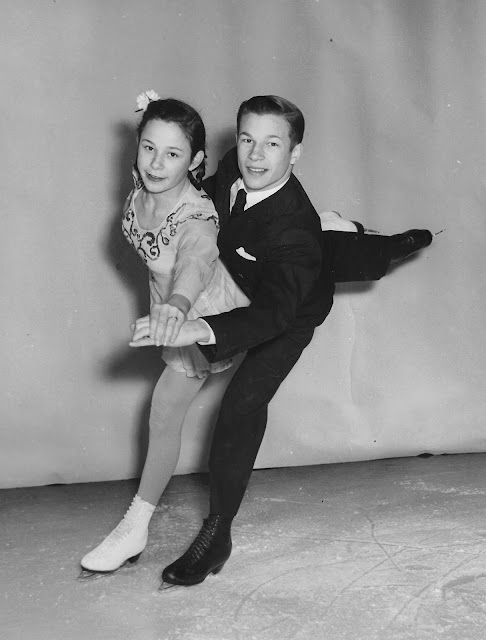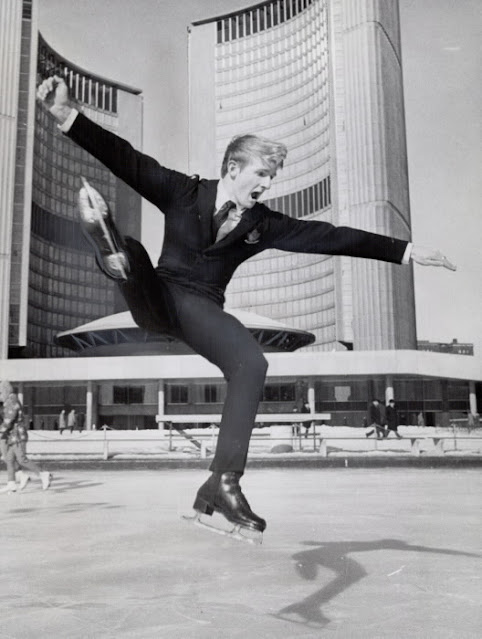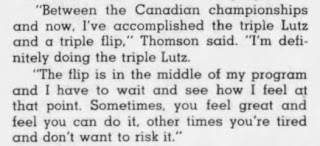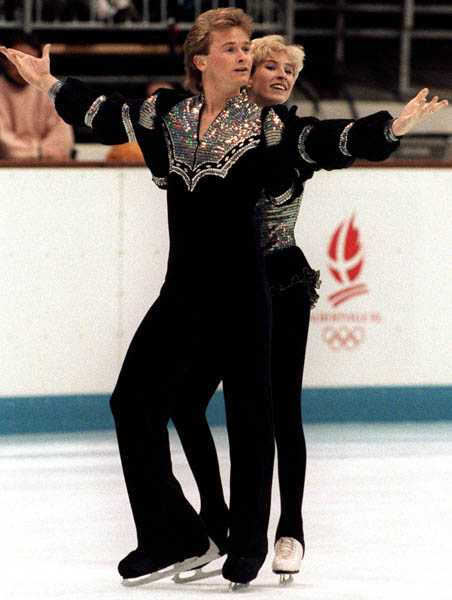There's a reason why Canadian skaters have dominated international figure skating competitions for decades. It's not just raw talent - it's the will to succeed, the dedication to practice and the drive to pursue excellence that has propelled so many skaters from Canada to the top of podiums over the years.
Not only can we lay claim to brilliant artists like Toller Cranston, Tessa Virtue and Scott Moir. We can also boast being home to the skaters who landed the first triple Lutz, triple Axel and quadruple jumps in competition... but that's just the tip of the Iced Cap.
If you nerd out over rotation and ratification, you're going to really love this airborne timeline. A big thanks to Donald Jackson, Debbi Wilkes, Kerry Leitch, Doug Haw, Meagan Duhamel, Doug Ladret, Mary Petrie McGillvray, John McKilligan, Doug Leigh, Mark Rowsom, Jean Westwood, Jay Humphry, Linda Carbonetto Villella, Valerie (Jones) Bartlett, Tina Tyan and Gordon Forbes for their help and input behind the scenes with this!
A note regarding this timeline: Jumping has obviously evolved over the years, both in the techniques skaters are taught and the way they are judged. In the twenties and thirties, skaters often turned a three out of their jumps because that was the technique that was taught at time. Until instant replay and the IJS system were introduced, there wasn't the same scrutiny we have today about the cleanliness of jump landings. This timeline may include jumps that were slightly cheated or had landings we'd consider iffy today, but far be it for us (in 2021) to nitpick the accomplishments of skaters from decades past who were breaking new ground. This is a 'living document' and if you have any suggestions or corrections, I'd love to hear from you and update it.
A TIMELINE OF CANADIAN JUMPING HISTORY
1895: George Meagher's book "Figure And Fancy Skating" is the first Canadian skating textbook to discuss jumping. Of the 'flying three' or waltz jump, he wrote, "This is a showy and particularly dashing figure when done properly, whether skated individually or done in combination."
1929: Constance Wilson includes an Axel jump in her winning program at the North American Championships in Boston. Her coach Gustave Lussi claimed, "Constance Wilson was the first female to perform the first real Axel but she still turned a three afterwards. And, after teaching it to her awhile, I was called down to the Committee room. They told me that I couldn't teach a jump like that to a lady. It was unladylike, likely to hurt her.
1929: Montgomery 'Bud' Wilson lands the double loop at the 1929 North American Championships in Boston. He is one of the first Canadian skaters to attempt the jump in competition.
1937: Montgomery 'Bud' Wilson is one of the first skaters in the world to attempt a double flip. Gustave Lussi claimed to have invented the flip with Wilson in the roaring twenties.
1940: Barbara Ann Scott wins the Canadian junior women's title in Ottawa with a free skating performance that included a double Salchow jump. That same year, she also landed the double loop at a Red Cross Carnival and Masquerade at the first Canadian summer skating school in Kitchener. She was only twelve years old at the time.
1942: Barbara Ann Scott is the first woman to land a double Lutz in competition, at the Canadian Championships in Winnipeg.
1948: Suzanne Morrow and Wally Distelmeyer up the bar by attempting side-by-side double jumps in competition.
1949: Twelve year old Barbara Gratton is the only woman to include a double Lutz and double toe-Walley in her free skating program at the Canadian Championships in Ottawa.
1953: Frances Dafoe and Norris Bowden popularized release jumps at a time when several judges claimed these innovations were illegal. Dafoe and Bowden performed the flying three jump and invented the leap of faith. Frances even performed an Axel into Norris' arms. In the years that followed, Dafoe and Bowden's successors Barbara Wagner and Bob Paul and their coach Sheldon Galbraith furthered the development of novel and unique pair moves that served as precursors to modern throws and twist lifts. Jean Westwood recalls Wagner and Paul performing a throw Axel as professionals.
1956: Ann Johnston is the first woman to do a double Axel at the Canadian Championships in Cambridge.
1958: In Ottawa, Donald Jackson is the first skater to land a triple jump - the Salchow - at the Canadian Championships. Charles Snelling had practiced the triple Salchow as well, but never attempted it in competition.
1962: Donald Jackson is the first skater to land a triple Lutz in international competition, at the World Championships in Prague. His performance, which earned seven perfect 6.0's, was the highest score recorded for a singles skater and was recorded as one of the first Guinness World Records for figure skating. At the time, a rumour was floating around about Sheldon Galbraith and Donald having a signal between them about the jump. He explained, "That happened in Prague in 1962 because Mr. Galbraith said I didn't have to do the triple Lutz if the warm up didn't feel right. During the warm up I checked the ice conditions where I would be doing my triple Lutz. I wanted to make sure the ice was thick enough so my toe wouldn't slip. I tried one in the warm up to get the feeling of the audience and the ice however I just did it close to where I was going to do it, not right where it would be in the competition. I didn't want to get caught in my own rut. I didn't land it cleanly but I wasn't really trying to land it, just get the feeling. I spotted Mr. Galbraith in the audience, he had gone back to his seat I guess, and I saw him and gave him the thumbs up signal because I felt good and was going to try it. He gave me the thumbs up back. This didn't ever happen as a regular thing though."
1962: Donald Jackson is the first skater in the world to work on a quadruple jump practice. He recalled, "I was working on a quad Salchow in in my last amateur year with Mr. Galbraith. It was part of my plan if I had stayed in. I was able to try it because I used a forward spin in the air and didn't have to bring my free leg out because it was already there. I could do three triple Salchows in a row that way too. It was easy. That I did in some shows. But I ended up turning professional so I didn't work on the quad any more."
1962: Maria and Otto Jelinek are the first pair in the world to land simultaneous double Axels at the World Championships in Prague. The jumps are performed in opposite directions.
1962: Petra Burka is the first woman to land a triple Salchow at the Canadian Championships. Attempts by women at triple jumps are rare in subsequent years. Linda Carbonetto lands one at the 1967 Canadians in Toronto and Mary Petrie executes one at the 1972 Canadians in London.
1963: Debbi Wilkes and Guy Revell are the first Canadian pair to execute a double Lutz twist at the Canadian Championships in Regina. Though not a jump, Wilkes and Revell's twist is an important precursor to the throws that would follow.
1963: In Edmonton, Donald McPherson is the first skater to land a triple loop at the Canadian Championships.
1966: A pair of sixteen year olds, David McGillvray and Doug Leigh, make a whole lot of jumping history in the junior men's event at the Canadian Championships in Peterborough. Doug is the first Canadian skater to land the triple flip and the first Canadian to do the triple flip and triple loop in a free skating program. David is the first Canadian to land a triple toe-loop and the first to do both a triple toe-loop and triple Salchow in a free skating program.
1967: In Montreal, Jay Humphry is the first Canadian to land a triple toe-Walley at North American Championships.
1968: British Columbia siblings Betty and John McKilligan are one of the first pairs to attempt the new throw Axel or 'Killer' at the Canadian Championships in Vancouver. Their attempt is unfortunately unsuccessful. Mary Petrie and Bob McAvoy land the throw the following year at the Grand Prix International de Patinage in St. Gervais, France. John McKilligan recalled, "Once upon a time throws and other 'acrobatic' moves were banned. I have no idea who was the first in Canada to complete a throw Axel in competition, but I believe that several of us probably did it shortly after it became a 'legal' move. My sister and I, with coach Jean Westwood, invented a few moves. The Cat Swing was a lift/throw where my sister did an Axel over my head after I boosted her into the air. We also did a 'jump camel spin' where I did a jump camel over my sister."
1973: Fourteen year old Vern Taylor is the first skater to land the triple Lutz at the Canadian Championships, in the novice men's event. He is also the first skater to perform the jump in the junior men's event at Canadians three years later.
1974: Ron Shaver is one of, if not the first, Canadian skaters to include three different triples (toe-loop, Salchow and loop) in his free skating program. Shaver later pushes the technical boundaries of the sport by opening his free skating program with a jump sequence of three triple toe-loop's.
1976: Lynne Begin and Marc Gignac are the first Canadian pair to do the throw double Axel, in their winning free skate in the junior pairs event at the Canadian Championships in London, Ontario. The next year in Calgary, fourteen year-old's Lorri Baier and Lloyd Eisler are the first novice pairs team to do a throw double Axel at the Canadian Championships.
1978: Barbara Underhill and Paul Martini up the ante for Canadian pairs, landing a throw triple Salchow in the junior pairs event at the Canadian Championships in Victoria, British Columbia. They performed the throw successfully for the second time in their winning free skate at the Nebelhorn Trophy in West Germany.
1978: Vern Taylor is the first person to land a triple Axel in competition, at the World Championships in Ottawa. Both he and Donald Jackson (the first man to do the triple Lutz) were students of Sheldon Galbraith.
1979: Brian Orser is the first Canadian skater to land the triple Axel at the Canadian Championships, in the junior men's event in Thunder Bay.
1979: Vern Taylor lands one of the first triple flip jumps in the senior men's event at the Canadian Championships in Thunder Bay. Gary Beacom also attempts the jump, but puts his hand down. Both Gary and Gordon Forbes land the jump the following year at the Canadian Championships in Kitchener.
1979: Brian Pockar makes history at the World Championships in Vienna as the first skater to land the unusual one-foot triple Salchow/double flip combination in international competition. All of the other skaters in the event performed the required double flip as the first jump in their combination in the short program. He told reporters, "I'm happy I chose that combination because I feel it made an impact here at the Worlds. It's an attention-getting device and I think people will remember me because of that."
1979: Heather Kemkaran is one of the first Canadian women to attempt the triple toe-loop in competition, at the Ennia Challenge Cup in The Hague. Over the next few years, Elizabeth Manley, Diane Mae Obigowski and Cynthia Coull are among a small group of Canadian women to land the jump in competition. Linda Carbonetto had done the triple toe-loop in practice back in the sixties, but didn't include it in her program. She recalled, "In those days, doing a double Axel was a big deal so it was felt that it was unnecessary."
1981: In February, Tracey Wainman is one of the first Canadian women to land a triple loop in practice... on Friday the thirteenth.
1983: At the Canadian Championships in Montreal, Kay Thomson is the first woman to land two triple Lutzes in one competition and the first woman to land a triple Lutz combination in the short program. That same year, she is the first Canadian woman to land a triple Lutz at the World Championships.
1984: Brian Orser is the first skater to land the triple Axel in an Olympic medal winning performance.
1984: Cynthia Coull and Mark Rowsom are one of the first pairs in the world to attempt two different throw triple jumps in one program - the Salchow and loop. Coull and Rowsom were also the first pair in Canada to attempt side-by-side triple toe-loop's and Salchows. Coull and Rowsom and Katherina Matousek and Lloyd Eisler were the first Canadian pairs to do the throw triple loop. Both pairs trained at the Preston Figure Skating Club with Kerry Leitch and were working on the throw at the same time.
1984: Kay Thomson is the first Canadian woman to attempt the triple flip in international competition, at the World Championships in Ottawa. The jump is rarely attempted by Canadian women in subsequent years.
1986: Barbara Underhill and Paul Martini are the first Canadian pair to successfully perform a throw triple jump in a professional competition, at the World Professional Championships in Landover, Maryland.
1987: In Cincinnati, Christine Hough and Doug Ladret are the first Canadian pair to land the throw triple toe-loop at the World Championships.
1987: Brian Orser makes history as the first skater to land two triple Axels in one program and three triple Axels in one competition at both the Canadian Championships in Ottawa and World Championships in Cincinnati.
1988: In Calgary, Elizabeth Manley is the first Canadian woman to land a triple loop in the Winter Olympic Games.
1988: Kurt Browning's quadruple toe-loop at the World Championships in Budapest is ratified as the first in performed in an ISU Championships. He also becomes the first Canadian skater to perform both a quadruple jump and a triple Axel in a free skating program. After the event, the Royal Glenora Club presented Kurt with a personalized license plate that said '1STQUAD'.
1988: Michael Slipchuk is the first Canadian skater to land triple/triple combinations in both the short and long programs, at the 1988 Trophée Lalique in Paris.
1989: In Chicoutimi, Kurt Browning is the first skater to land a quadruple jump at the Canadian Championships. That same year, he is the first skater to land two triple triple Axels in the original program at the World Championships in Paris.
1990: Donald Jackson, the first Canadian skater to land a triple jump in competition in 1958, celebrates his fiftieth birthday by landing a beautiful triple Salchow at the Minto Skating Club.
1990: Lisa Sargeant is the first Canadian woman to attempt a triple Axel in competition, at Skate Electric in London, England. She lands the jump on two feet.
1990: Kurt Browning is the first skater to land a triple Salchow/triple loop combination in competition, at the Nations Cup in Gelsenkirchen. He also landed a triple flip/triple toe-loop in his free skating program.
1991: Kurt Browning is the first skater to land three different triple/triple combinations in one program, at the World Championships in Munich. He does the triple Axel/triple toe-loop, triple flip/triple toe-loop and triple Salchow/triple loop.
1991: Elvis Stojko is the first skater to land a quadruple jump in combination at an ISU Championship, at the World Championships in Munich.
1991: One of the first Canadian women to land a triple flip in international competition is Karen Preston at Skate Canada in London in 1991. In Oakland the following year, Karen is the first Canadian woman to land the triple flip at the World Championships.
1992: In Albertville, Sherry Ball and Kris Wirtz are the first Canadian pair to land back-to-back side-by-side triple toe-loop's at the Winter Olympic Games.
1994: Three of Canada's biggest jumping greats square off at the Canadian Championships in Edmonton. Elvis Stojko, the winner, was the first skater to land a quadruple jump in combination at an ISU Championship. Kurt Browning, the runner-up, was the first skater to land a ratified quad at an ISU Championship. Vern Taylor, who finished dead last but earned the respect of the crowd for his comeback, was the first skater to land a triple Axel at an ISU Championship... sixteen years prior.
1994: Josée Chouinard is the first Canadian woman to land a triple Lutz in professional competition at the Canadian Professional Championships in Hamilton.
1995: Kurt Browning is the first Canadian skater to land a triple Axel in a professional competition at the tenth annual Challenge Of Champions in Tokyo, Japan.
1996: Elvis Stojko lands a quadruple Salchow in one of the practice sessions at the Canadian Championships in Ottawa.
1997: Around the same time Éric Millot of France and Tara Lipinski of the United States make history as the first skaters to successfully land the rare triple loop/triple loop jump in competition, Yvan Desjardins is one of the first Canadian skaters to land it in practice. In the years that follow, Shawn Sawyer, Joannie Rochette, Meagan Duhamel and Nicole Watt are part of a small group of skaters that practice the combination.
1997: Elvis Stojko is the first skater in the world to land a quadruple/triple combination in an ISU Championship, at the Champions Series Final in Hamilton. That same year, he became the first to land the combination at the World Championships. He was also the first skater to land a quadruple jump in combination at the Canadian Championships that season.
2000: Brian Orser, the first skater to land the triple Axel at the Canadian Championships in 1979, performs the jump for the first time in twelve years at the 2000 Winter Goodwill Games in Lake Placid.
2001: In Winnipeg, Jayson Dénommée is the first skater to land the triple Axel/triple loop combination at the Canadian Championships.
2001: Emanuel Sandhu is the first skater to land a triple toe-loop/triple toe-loop/triple toe-loop combination in competition at the 2001 Sears Canadian Open in Ottawa. France's Surya Bonaly had landed the three triple combination in a practice session in the autumn of 1991 at an Olympic test event, the Trophée Lalique in Albertville.
2005: British Columbian pair Jessica Miller and Ian Moram are the first Canadian duo to attempt a throw quad Salchow in competition, at a summer event in Pierrefonds. They landed the throw in a practice at the 2007 Cup Of China and got credit for the rotation when they attempted it in the free skate at that event. One of the first pairs to attempt a throw quad in practice were Marie-Claude Savard Gagnon and Luc Bradet, in the early nineties.
2005: Meagan Duhamel and Ryan Arnold are the first pair to land side-by-side triple Lutzes and a throw triple Lutz at the Canadian Championships in London. At that season's World Junior Championships in Ljubljana, Duhamel and Arnold became the first pair to land the throw triple Lutz in international competition. The technical specialist apparently didn't even have a button in their system for the throw triple Lutz because it was so rare, so they pressed the throw triple flip button instead.
2006: In Ljubljana, Kevin Reynolds is the first Canadian skater to land a quadruple Salchow at the World Junior Championships.
2007: In Halifax, Kevin Reynolds is the first skater to land two different quadruple jumps at the Canadian Championships.
2008: Kevin Reynolds is the first Canadian skater to land a quadruple/triple/triple combination, at the Canadian Championships in Vancouver.
2010: Kevin Reynolds is the first skater in the world to land two different quadruple jumps in a short program at Skate Canada International in Kingston.
2012: After winning his first two World titles and turning the quadruple toe-loop into a masterclass, Patrick Chan works on quadruple Salchow and quadruple flip jumps in practice. Patrick lands his first quadruple Salchow at the 2016 ISU Grand Prix Final and his second at the 2017 Canadian Championships.
2013: Kevin Reynolds is the first skater to land five quadruple jumps in one competition, at the Four Continents Championships in Osaka. He did two in the short program and three in the free.
2014: In Sochi, Meagan Duhamel and Eric Radford are the first pair in the world to land side-by-side triple Lutzes in the Winter Olympic Games.
2015: Meagan Duhamel and Eric Radford are the first pair in the world to land the throw quadruple Lutz, the first to perform a back-to-back throw quad Salchow and throw quadruple Lutz in practice and the first to attempt back-to-back throw quads in competition at the Souvenir Georges-Éthier competition in Québec.
2016: Meagan Duhamel and Eric Radford are the first Canadian pair to land a throw triple Axel in competition at Skate Canada International in Mississauga.
2017: Kevin Reynolds is the first skater to land six quadruple jumps in one competition, at the World Championships in Helsinki. He did two in the short and four in the free.
2017: In Ottawa, Nicolas Nadeau is the first skater to land the quadruple loop at the Canadian Championships.
2018: At age thirteen, Stephen Gogolev is the youngest skater to land a quadruple Lutz, quadruple Salchow and quadruple toe-loop in international competition, at the Junior Grand Prix event in Bratislava. Gogolev is also the first Canadian skater to land the quadruple Lutz in competition.
2018: In Pyeongchang, Meagan Duhamel and Eric Radford are the first pair ever to execute a throw quadruple Salchow at the Winter Olympics.
2020: Figure skater Meagan Duhamel and hockey player Wojtek Wolski are the first hockey player/figure skater duo to land a throw triple Salchow on CBC's hit show "Battle Of The Blades".
Skate Guard is a blog dedicated to preserving the rich, colourful and fascinating history of figure skating. Over ten years, the blog has featured over a thousand free articles covering all aspects of the sport's history, as well as four compelling in-depth features. To read the latest articles, follow the blog on Facebook, Twitter, Pinterest and YouTube. If you enjoy Skate Guard, please show your support for this archive by ordering a copy of figure skating reference books "The Almanac of Canadian Figure Skating", "Technical Merit: A History of Figure Skating Jumps" and "A Bibliography of Figure Skating": https://skateguard1.blogspot.com/p/buy-book.html.




